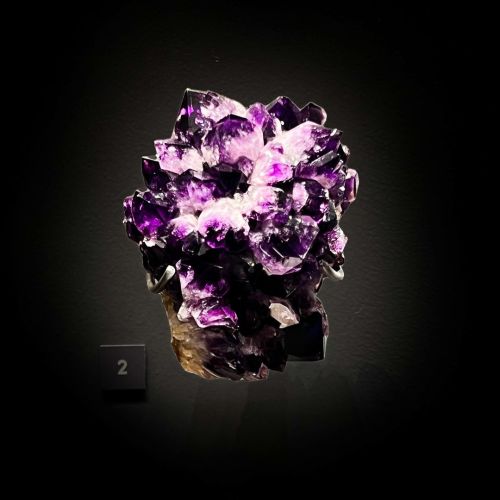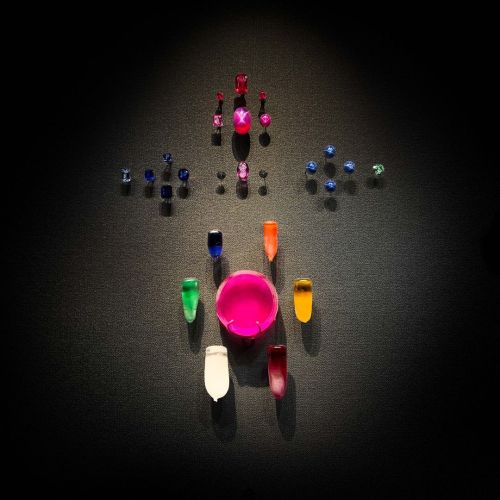#newyorkrocks
It’s time for #MineralMonday! The dazzling colors seen in gem tourmalines depend on the metals present in each gemstone’s crystal structure. Pink tourmalines contain more manganese, while green crystals include iron, chromium, or vanadium. When conditions change during crystal growth, tourmalines can grow as bi-colored and multicolored crystals, such as watermelon elbaite—such as the specimen pictured!
Fun fact: Unlike most minerals, tourmaline, when heated, develops opposite charges at each end. This property of tourmaline crystals—pyroelectricity—produces a positive charge at one end and a negative charge at the other.
Photo: E. Louis/© AMNH
#NewYorkRocks #gems #minerals #crystals #watermelon #elbaite #tourmaline #geology #amnh (at American Museum of Natural History)
https://www.instagram.com/p/Cbpc741L3sf/?utm_medium=tumblr
Post link
Have you ever wondered how big crystals form? Let’s talk about it this #MineralMonday.
Pegmatites produce large crystals—usually over ~1⁄2 inch (1 cm)—and are the final product of some cooling magmas. They’re found in veins, dikes, or pods at or near the margins of large igneous bodies. Large crystals and distinctive textures can form in pegmatites because high concentrations of water and certain chemical elements in their magmas reduce the number of crystal nuclei that form. Water also allows pockets to form where minerals, like this beryl (variety: aquamarine), can grow unimpeded as large well-defined crystals.
Photo: E. Louis/© AMNH
#NewYorkRocks #crystals #gems #minerals #NaturalHistory #amnh (at American Museum of Natural History)
https://www.instagram.com/p/CbXXBdoLnYh/?utm_medium=tumblr
Post link
It’s time for #MineralMonday! Amethyst, citrine, agate, chalcedony, jasper, and dozens of other names are used for beautiful minerals of many different colors and textures. But did you know? They’re all varieties of quartz!
Quartz is the second-most common mineral on Earth and it makes up most of the sand on many beaches. What distinguishes the quartz varieties is the size of their crystals and the causes of the different colors.
Photo: E. Louis/© AMNH
#NewYorkRocks #gems #minerals #rocks #crystals #quartz #purple #NaturalHistory #amnh #DYK #museums (at American Museum of Natural History)
https://www.instagram.com/p/CdDoTa2LwoI/?igshid=NGJjMDIxMWI=
Post link
This #MineralMonday, let’s learn about synthetic gems. A synthetic gemstone is created in a lab but is the same substance as the natural gemstone.
In 1902, French chemist Auguste Verneuil announced his method for producing synthetic ruby–the first commercial synthetic gem ever created. The Verneuil process, or flame fusion, melts powdered gem material in a flame onto a rod. Other processes include pulling crystals from molten gem material, or growing them from molten mixtures with a flux from high-temperature hydrous fluid.
Photo: E. Louis/© AMNH
#NewYorkRocks #gems #minerals #SyntheticGems #amnh #NaturalHistory #jewelry #geology #jewels (at American Museum of Natural History)
https://www.instagram.com/p/CcxpLqiLx9o/?igshid=NGJjMDIxMWI=
Post link
It’s time for #MineralMonday! The dazzling colors seen in gem tourmalines depend on the metals present in each gemstone’s crystal structure. Pink tourmalines contain more manganese, while green crystals include iron, chromium, or vanadium. When conditions change during crystal growth, tourmalines can grow as bi-colored and multicolored crystals, such as watermelon elbaite—such as the specimen pictured!
Fun fact: Unlike most minerals, tourmaline, when heated, develops opposite charges at each end. This property of tourmaline crystals—pyroelectricity—produces a positive charge at one end and a negative charge at the other.
Photo: E. Louis/© AMNH
#NewYorkRocks #gems #minerals #crystals #watermelon #elbaite #tourmaline #geology #amnh (at American Museum of Natural History)
https://www.instagram.com/p/Cbpc741L3sf/?utm_medium=tumblr
Post link




